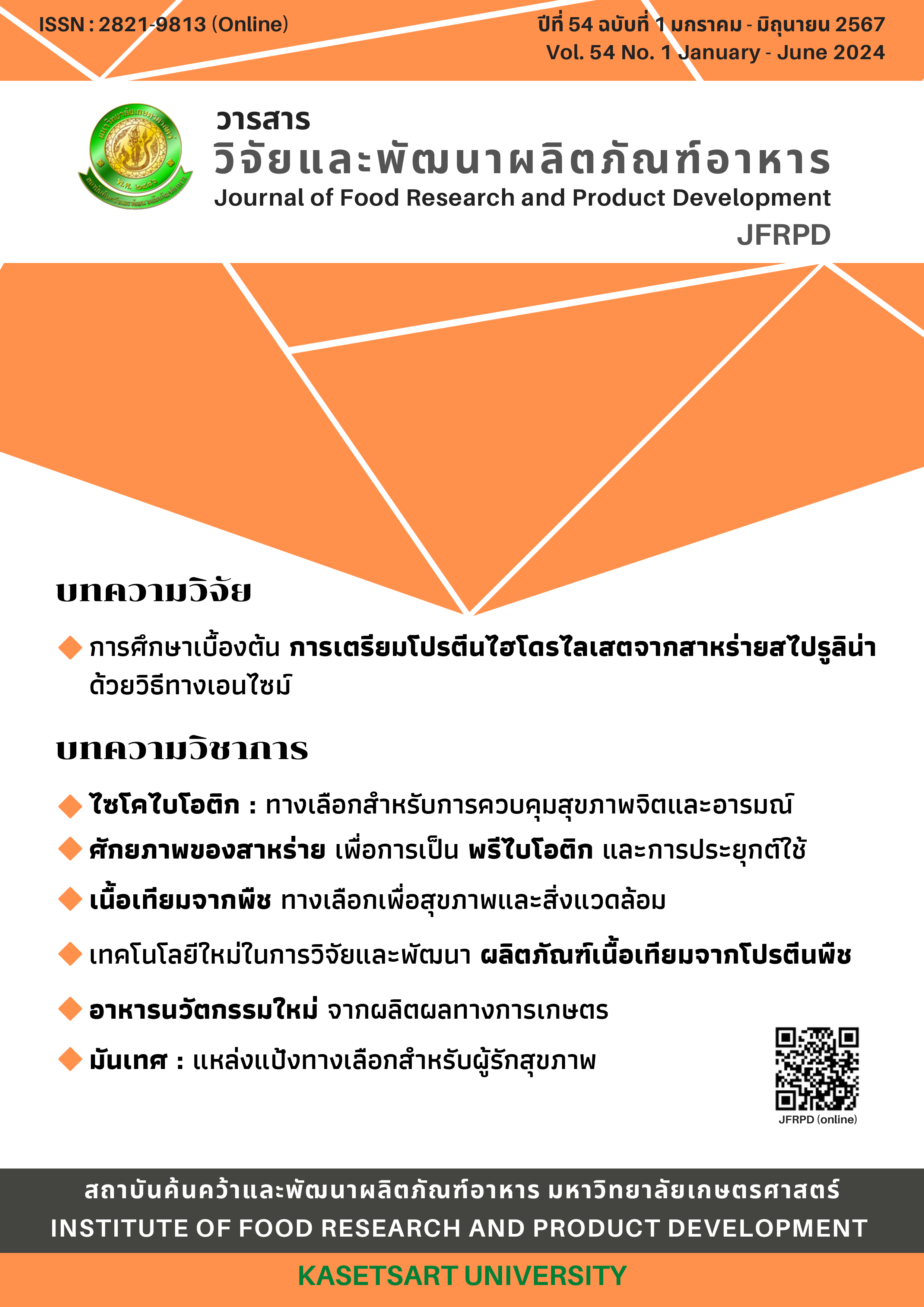ศักยภาพของสาหร่ายเพื่อการเป็นพรีไบโอติดและการประยุกต์ใช้
##plugins.themes.bootstrap3.article.main##
摘要
ประชากรโลกมีความสนใจในการบริโภคอาหารเพื่อสุขภาพ มีคุณค่าทางอาหาร และเป็นแหล่งของพรีไบโอติก สาหร่ายอุดมไปด้วยคุณค่าทางโภชนาการ ประกอบด้วย คาร์โบไฮเดรต โปรตีน และกรดไขมันไม่อิ่มตัวซึ่งมีฤทธิ์ทางชีวภาพสูง ซึ่งพอลิแซ็กคาไรด์จากสาหร่ายมีศักยภาพการเป็นพรีไบโอติก และสามารถประยุกต์ใช้สำหรับอาหารเพื่อสุขภาพ เนื่องจากมีฤทธิ์ต้านอนุมูลอิสระ ต้านมะเร็ง ลดความดันโลหิต และคุณสมบัติเชิงสุขภาพหลากหลาย บทความนี้กล่าวถึงสาหร่ายทั้งสาหร่ายขนาดใหญ่และขนาดเล็ก คุณค่าทางอาหารของสาหร่าย ศักยภาพของสาหร่ายเพื่อเป็นสารพรีไบโอติกและการประยุกต์ใช้ในผลิตภัณฑ์อาหาร และการทำงานของพรีไบโอติกจากสาหร่ายร่วมกับโพรไบโอติกรวมทั้งผลต่อการส่งเสริมสุขภาพ
##plugins.generic.usageStats.downloads##
##plugins.themes.bootstrap3.article.details##
参考
Terpou A, Papadaki A, Lappa IK, Kachrimanidou V, Bosnea LA, Kopsahelis N. Probiotics in food systems: Significance and emerging strategies towards improved viability and delivery of enhanced beneficial value. Nutr. 2019;11(7):1591.
Patel AK, Singhania RR, Awasthi MK, Varjani S, Bhatia SK, Tsai M-L, et al. Emerging prospects of macro- and microalgae as prebiotic. Microb Cell Fact. 2021;20(1):112.
Gotteland M, Riveros K, Gasaly N, Carcamo C, Magne F, Liabeuf G, et al. The pros and cons of using algal polysaccharides as prebiotics. Front Nutr. 2020;7.
Dawczynski C, Schubert R, Jahreis G. Amino acids, fatty acids, and dietary fibre in edible seaweed products. Food Chem. 2007;103(3):891-9.
Vassilev SV, Vassileva CG. Composition, properties and challenges of algae biomass for biofuel application: An overview. Fuel. 2016;181:1-33.
Babich O, Ivanova S, Michaud P, Budenkova E, Kashirskikh E, Anokhova V, et al. Fermentation of micro- and macroalgae as a way to produce value-added products. Biotechnol Rep. 2024;41:e00827.
YalÇIn D, Ilikkan Ö, BaĞDat E. Evaluation of prebiotic, probiotic, and synbiotic potentials of microalgae. Food Health. 2022;8(2):161-71.
Ilknur B, Birsen K, Hamideh M. Major Natural Vegetation in Coastal and Marine Wetlands: Edible Seaweeds. In: Manuel TO, Feyza C, Anabela F-S, editors. Plant Communities and Their Environment. Rijeka: IntechOpen; 2019. p. Ch. 9.
Lewmanomont K. Some Edible Algae of Thailand. Agr Nat Resour. 1978;12(2):119-33.
Andrade L, De Andrade CJ, Dias M, Nascimento C, Mendes M. Chlorella and spirulina microalgae as sources of functional foods, nutraceuticals, and food supplements; an overview. MOJ Food Process Technol. 2018;6:00144.
Rajapakse N, Kim S-K. Chapter 2 - Nutritional and Digestive Health Benefits of Seaweed. In: Kim S-K, editor. Advances in Food and Nutrition Research. 64: Academic Press; 2011. p. 17-28.
Thiviya P, Gamage A, Gama-Arachchige NS, Merah O, Madhujith T. Seaweeds as a source of functional proteins. Phycol. 2022;2(2):216-43.
Wang Y, Tibbetts SM, McGinn PJ. Microalgae as sources of high-quality protein for human food and protein supplements. Foods. 2021;10(12).
Duttaroy AK. Chapter 8 - Polysaccharide on diabetes, obesity, and other cardiovascular disease risk factors. In: Duttaroy AK, editor. Evidence-Based Nutrition and Clinical Evidence of Bioactive Foods in Human Health and Disease: Academic Press; 2021. p. 115-28.
Babich O, Sukhikh S, Larina V, Kalashnikova O, Kashirskikh E, Prosekov A, et al. Algae: study of edible and biologically active fractions, their properties and applications. Plants [Internet]. 2022; 11(6).
Rodrigues D, Freitas AC, Pereira L, Rocha-Santos TA, Vasconcelos MW, Roriz M, et al. Chemical composition of red, brown and green macroalgae from Buarcos bay in Central West Coast of Portugal. Food Chem. 2015;183:197-207.
Cindana Mo’o FR, Wilar G, Devkota HP, Wathoni N. Ulvan, a polysaccharide from macroalga Ulva sp.: a review of chemistry, biological activities and potential for food and biomedical applications. Appl Sci. 2020;10(16):5488.
Lopez-Santamarina A, Miranda JM, Mondragon ADC, Lamas A, Cardelle-Cobas A, Franco CM, et al. Potential use of marine seaweeds as prebiotics: a review. Mol. 2020;25(4).
Moreira JB, Vaz BdS, Cardias BB, Cruz CG, Almeida ACAd, Costa JAV, et al. Microalgae polysaccharides: an alternative source for food production and sustainable agriculture. Polysaccharides. 2022;3(2):441-57.
Shannon E, Abu-Ghannam N. Seaweeds as nutraceuticals for health and nutrition. Phycologia. 2019;58(5):563-77.
Paola Scodelaro B, Gabriela AS, Patricia IL. Fatty acids from microalgae: targeting the accumulation of triacylglycerides. in: angel C, editor. Fatty Acids. Rijeka: IntechOpen; 2017. p. Ch. 7.
Rondevaldova J, Quiao MA, Drabek O, Dajcl J, Dela Pena-Galanida GD, Leopardas VE, et al. Mineral composition of seaweeds and seagrasses of the Philippines. Phycologia. 2023;62(3):217-24.
Škrovánková S. Seaweed vitamins as nutraceuticals. Adv Food Nutr Res. 2011;64:357-69.
Gentscheva G, Nikolova K, Panayotova V, Peycheva K, Makedonski L, Slavov P, et al. Application of Arthrospira platensis for medicinal purposes and the food industry: a review of the literature. Life (Basel). 2023;13(3).
Sonchaeng U, Wongphan P, Pan-utai W, Paopun Y, Kansandee W, Satmalee P, et al. Preparation and characterization of novel green seaweed films from Ulva rigida. Polymers. 2023;15(16):3342.

